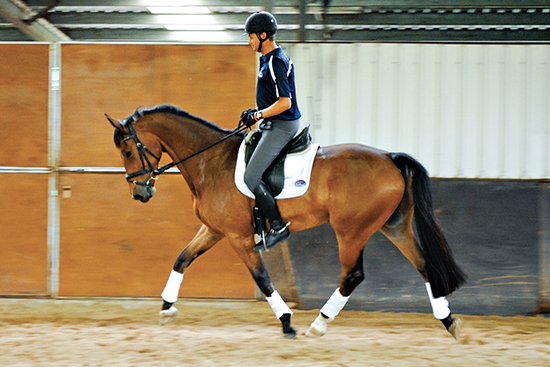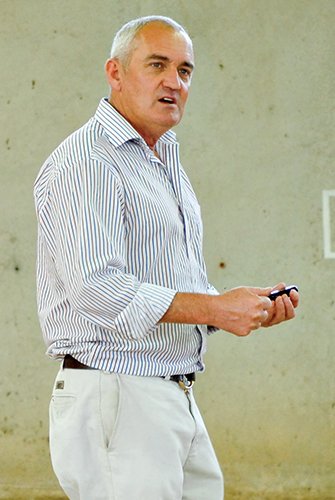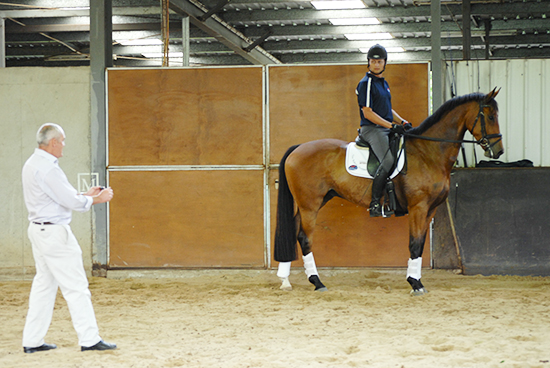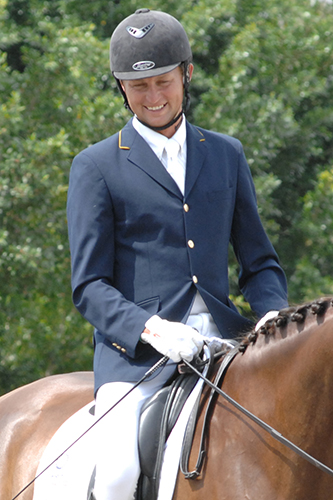 Tor Van Den Berge takes a lesson with Andrew McLean
Tor Van Den Berge takes a lesson with Andrew McLean
Story by Shannan Makauskas and photos by Alex Makauskas
With the era of quick fixes and training fads passing, and the art of classical dressage returning, Equitation Science arrived at a time when were ready to question the way we train the modern dressage horse.
Andrew McLean has been at the forefront of this movement and is one of the first to educate equestrian enthusiasts around the world about horse psychology and the way horses learn.
Many of the principles, such as the use of pressure and release, as well as employing light and easily discernable aids, may not be anything new to the way we train dressage.
But what the ‘McLean method’ has brought to the fore is a responsibility and a way of thinking that holds the rider accountable for their actions. Every aid has a purpose and timing is critical. Even better, Andrew developed a clearer way of explaining the movements and the aids so any rider can understand them.
Although this will make training easier to digest by riders, Andrew acknowledges it won’t guarantee true Dressage excellence. As written by Andrew in one of his articles for THM: “Training is half the story, correct riding skill is the other half, and those who achieve at elite level tend to get both sides right.”
One rider who has ridden to an elite level is Tor Van Den Berge, with numerous National titles to his name as well as being a representative for Australia at the World Young Horse Championships.
Tor’s riding career began in breaking and after many years of eventing, showing and dressage, was further developed by training at the PSI stables in Germany under Ulf Möller and Bianca Kasselman.
This makes Tor a product of the German system and the Training Scale. But what Tor also reflects in his riding style is a straightforward approach and respect for the horse, making him a great subject for Andrew to work with.
Lesson
Riding the five year old gelding, Kaludah Jetstar (Jive Magic/Salute), Tor hoped to get some help with the horse’s shying issues: “When he came to me he was very backward and very spooky. But he’s getting better and better everyday. The movements aren’t going to be a problem but he’s got to go through and stay there.”
Tor has secured shares in the horse and will be competing him this year: “I really enjoy riding him and he’s a good mover. Once you get him in front of the leg he’s easy, but we all need something to butt heads with, and Mel’s had the baby now so I can’t butt heads with her anymore,” he laughs.
Andrew outlines the way he starts a lesson: “The plan for me is to find out what the problems are and work on that. There are ten things we do in checking the basics. The four things from the reins are that the horse can go down a gait, he can slow the legs, shorten his stride and that he can step back. From the leg aid there’s three things: we make sure he can go up a gait, come more active and lengthen the stride.”
“There are two turns the horse needs to know, a direct turn which is just your basic turn left or right. And an indirect turn, which is the rein away from the neck and the rein against the neck. Then there’s the one leg yield response. Once all of those are trained by pressure release and we get them all right, then we’re on track. I always start by getting the rein and leg happening before I do turns because stop and go is more fundamental than turn.”
This is different to how Tor usually begins his training sessions: “I like to pick-up where I left the day before. I expect the basics to be on already when I walk onto the arena. So I don’t necessarily go and check them everytime. But with a horse that I haven’t had for long, or one that’s having a few problems I run through them.”
With rain pounding on the roof of the Indoor, it didn’t take long for the young gelding to reveal the main problems. Andrew said: “He can get tense. He doesn’t listen to the aids mainly for stop and turning. This leads to shying. So we will begin by looking at the basics of stop and turn.”
Andrew breaks down the mechanics of shying: “When a horse spooks it does two things, it opens its front legs and pushes away and then the back legs will push to take off. What this shows us is it’s a front leg issue and therefore it’s a turn issue. The deepest turn aid we have comes from the rein. Therefore what I’ll do are some exercises with the horse to get him back under stimulus control of the reins. Then we can put his leg where we want, even in difficult places.”
“I’ve got an exercise where we ride against the wall and we go closer to the wall than we’d normally go. A spooky horse doesn’t always want to do it. Then we have some brake issues so we’ll work on that too. I just like looking at all the basics. All the things down in the engine room; like how he goes from the legs, how he stops from the reins and how he turns from the single rein.”
Tor trots on a circle around Andrew, making transitions to halt every few strides. Andrew says: “As soon as he makes one mistake you go back and do five repetitions. After that the mistakes will come much further apart.”
To further establish the stop aid Andrew checks the submission of the reinback. But in the first step the horse shortens the neck: “Now that’s an interesting one. You can almost expect it because a lot of the Jazzs can come behind the bit a little. But horses that shy always give a first response of shutting (shortening) the neck in the reinback. It means he doesn’t exactly know the answer to the question.”
Andrew directs Tor to lift his hands to keep the horse from closing the gullet in the reinback: “Raise your hands a bit higher so he doesn’t shut (shorten) his neck first and then give after the first response. Then he’ll give an answer with his leg instead of his neck. Do a few more of those and keep your hands up. If he’s not getting it release after the second step. So you can say, ‘Yes that’s the right answer’, rather than shutting the neck.”
Tor commented on correcting the neck this way: “I normally try to fix it from the leg but it was effective with this particular horse.”
Now it’s on to the next step to improve the reinback: “You can add more pressure to that by getting him more active in the steps going back. It’s just getting him to know that answer in the reins. This will help him understand the stop aid better as well, so he’ll do a downward transition without shutting the neck.”
Andrew links horses’ shortening of the neck to shying: “It’s amazing how a lot of other behaviors that surrounds these problems seem to be unrelated, but actually are related because they diminish as soon as the horse is clearly trained in stop and go. You can do what you like to stop shying, but the more horses shut their necks – it tends to make them get a bit insecure – and then they start to shy.”
It’s back on the circle to work on the stop and go aids: “I want to do transitions from halt to trot and trot to halt. I want his back legs to freeze when you use the rein aid. You’ll find this is a good way of getting them really connected.”
“What you want him to do is trot in diagonal pairs all the way down to the halt, every walk step he does is telling you he’s backing off the stop and not really doing it because it’s hard work. The first step is to get the diagonal pairs together. The second step is to get him square and that will just happen by itself when he steps evenly. The third step is when his back legs come one hoof print closer to his front legs and come under, that’s where he really sits.”
Tor rides a few halts and Andrew notices the left hind is not stepping up to make the halt square: “When you do the stop, because his left hind leg is out, it will tell you the right front leg is not really answering the stop aid. So you can use a little more right rein just to even it out and make that diagonal pair come together.”
The halt is straight and square, so it’s on to step three: “Now we just want his back legs to dig in and sit. Good, perfect, well done, that’s exactly what we wanted. Now to make that a habit we want to get three good ones in a row which is hard. But if you get three and then come back in the later sessions to check it, the success rate is higher than if you only got one.”
Andrew highlights the quickest way to see results: “It’s best to make this transition every three strides because the closer we bring them together the quicker they learn.”
Tor reflects on the exercise: “With repetition I’ve always aimed to get it right twice. If I need to repeat something several times I usually vary it so it doesn’t become a drill.”
The key aspect of Andrew’s training is letting the horse know when he’s given the correct response: “When he comes lighter make a big deal of it. Say, ‘good boy’ and give him a scratch. If you scratch them on the wither it lowers the heart rate by 10 beats per minute, whereas patting has no effect.”
Tor, who is always giving his horse a big pat after the test, said: “Yeah I can’t say I do that, it’s not really something I think about.”
Andrew justifies his reward theory: “It’s not good enough to just say good boy because they don’t know what you’re saying. You’ve got to pair it with something like scratching him. Then eventually he’ll start to put an ear back and listen when you say it.”
Training the horse using pressure and release is the key to riding with light aids. But Andrew doesn’t believe in the seat as an aid on its own: “However good he is from the seat only rests on how good he is from the rein and the leg. In the end, if he’s no good from the seat, you’re not going to be able to make him do things with just your seat so you’re going to have to go back to something that works.”
Tor reflects on using the seat: “We’re always aiming to get the horse responding to a seat aid but most of the time it’s leg and seat. Although Ulf Möller always said, ‘You need to be able to ride your horse with no reins.’ And that’s something that really stuck with me.”
Andrew explains his reasoning: “Seat aids are more classical conditioning, which means they learn them by association. It’s very difficult to train a horse just from your seat without ever using any leg or rein and it would be highly unreliable because you can’t enforce it. So what reins and legs do is they actually enforce the response and they can perfect it and build it up so it all happens from light aids.”
Now it’s time to work on the turns: “A direct turn is when you pull right the horse goes right. Like if you’re cantering towards a cross country fence and the horse veers left you pull your right rein to get it back on track, that’s a direct turn.”
“But there’s an old French turn called an indirect turn which is really useful. People don’t always know the indirect turn, but the horse, once you get past advanced, knows this turn. In England I say, ‘Have you every heard of an indirect turn?’ And they say, ‘No’. And I say, ‘Okay just do this with your rein’. And the horse always knows it.”
Andrew instructs Tor on how to begin training the indirect turn: “Stay on a circle on the left rein and put both your hands to the outside. It’s the inside rein pushing against the neck and his body flexed left and basically front legs are turning right. Yeah like that. It’s a real help for fixing horses that shy. You probably already do it but just didn’t have a name for it.”
“The indirect turn has two stages of development in the dressage horse because this turn you’re doing now is what a horse does until it’s elementary. But after that when you’re introducing all the lateral movements you need to be able to actually use your rein against his neck. Hold him in the flexion there and bring your hands towards me, but push. It helps for your half pass when you want to get him going towards the bend.”
Now the responses to the basics have been established, Tor is ready to tackle the shying issue. Andrew says: “I want you to ride along the wall but with his front hoof as close to the wall as possible. Get his front legs on the line you want. Shying is a line issue.”
Traditionally shoulder-fore or shoulder-in is used to keep the horse on the outside track and stop them from looking outside the arena. Andrew says: “That can also work but they can escape you in shoulder-in too easily. Whereas this way you’re saying, ‘I don’t care where your head is, or your bum, but you’re going to put your foot here and not there’.”
“If he does shy you’ve got to pull him back right. Just make sure his front legs stay on your line. You’ve got to attach your left rein to the left front leg and the right rein to the right front leg. Don’t worry about his bum in this moment because he’ll make it straight later when he’s going along your line. Just say, ‘I want your left front leg two inches from the wall every step’.”
Andrew instructs Tor on what to do when the horse reacts to sound: “If that makes him turn, pull him back. Don’t be afraid to give the rein a stronger tug if he jumps away. See if you can use more leg, you might have to push and kick to get him there. When he gets close reward him.”
“They’re always afraid of what they haven’t experienced. Once they do it it’s not so bad. If he wants to sniff it let him but if he pulls back push him forward again. Well done you caught that one.”
Correcting a spooky horse this way can be confrontational but Tor says it’s a method he‘s always used: “This is similar to how I’ve done it in the past, keeping them focused on your line until they accept it. But I’ve had horses that are better when you avoid it until they are really into their work. Usually, once they’re through and on the aids, they stop shying by themselves. But it depends on the horse.”
Andrew believes bomb-proofing today’s Warmblood is a more difficult task: “That’s an old philosophy, that if the horse is on the aids it doesn’t shy. The trouble is the modern breed of horse is more sensitive and they seem to lose it at the drop of a hat. There are more horses the average person can’t ride nowadays. They are a lot more reactive.”
Andrew gives advice on helping horses who get tense in indoor arenas, where loud sounds and big crowds can be distracting: “That’s where overshadowing comes in. Once he gets a bit more comfortable with the exercise you can bang the wall with your stirrup. If you bang the wall, and he’s noise sensitive and he shies from that as well, we have to overshadow the effect of the environment with the aids.”
With the horse happily walking next to the wall, even with Tor’s stirrup banging along it, Andrew says: “When you think about shying it’s just a random swerve, so catch it with your reins. When you’re not giving a rein aid it means he should stay on your line. Good. Well done, that’s it.”
Andrew reflects on the aids: “Basically all you’re trying to do is retrain your rein aids and every horse is different. Some undo your aids so fast and others, after hardly any training, are right for life. You want to make sure the right rein is always connected to the right leg.”
Tor comments on this approach: “That’s something I’ve never been taught. For me its right rein to left hind and left rein to right hind. But it could be the same thing because that’s the diagonal pairs. I’m just always thinking more towards the hind legs.”
Andrew said: “Once it feels good off your direct rein, do it off your indirect rein. You can’t really enforce the indirect rein as effectively though so you don’t want to do it until the direct rein has been properly established. The last thing you would do to test it is leg yield along the wall and put his bum right along the wall, like an exaggerated shoulder-in.”
Tor comments on the exercise: “It’s exactly right because you’ve got to be able to put them wherever you like.”
Andrew: “It’s easy to forget that just because we’ve got reins to their mouth, the reins and leg aren’t connected. You need to think of the left rein as the left front leg and the right rein as the right front leg. In all the gaits you should be able to slow them, lengthen them, shorten them and later even raise them. They have to know all about mobility and control. They know very well when you loose it. But once you have them under control they’re relaxed.”
This brings us to the end of the lesson and it’s clear that although Andrew has a system, he’s open to suggestions: “Learning theory is not necessarily a prescription where you’ve got to do this and then you’ve got to do that. I’m always swapping and moving and changing bits as time goes on. I recognise there are other ways of doing things.”
And perhaps this is what works so well in the lesson, Tor brings his own riding style to the mix and Andrew directs it towards a formula. The question is; will the ‘McLean method’ be added to the list of training fads? Or is it time classical dressage took a scientific approach? With the increasing concern for horse welfare, something tells me Andrew’s methods are here to stay.
 Shannan caught up with Tor to get his thoughts on the lesson:
Shannan caught up with Tor to get his thoughts on the lesson:
“It was very effective and it’s interesting to put it into a system. To make it a little bit more regimented where you attack one thing first and then go to the next. Rather than trying to battle on through all of it at once. I think there was a result at the end of it. He’s not an easy horse but it gets easier every day.”
How was that different to the way you normally ride?
“Well I think no it wasn’t that different. I really think we don’t go on unless our aids work and we test all our aids. Maybe Andrew does it in a more organised fashion than we do, but I think most of us go back to training a light reaction from our aids if things aren’t working. I think it’s very similar to what we normally do.”
Andrew is against simultaneous leg and hand aids but I could see your legs were on a lot of the time and the rein was coming on and going off…
“Yeah legs definitely on and he said that I had leg on a lot of the time but I think definitely you have to keep the leg for activity. You can’t do that without leg. I think the way he’s trying to describe the method is more the important thing and trying to get it through to people, the basics. “
A few months after the lesson, I asked Tor if he continued using any of the methods…
“It hasn’t changed the way I train the horse and Peter’s going very well now. But I knew his flaws going into the lesson and Andrew picked-up on all of those very well. It’s just a matter of progress.”
This article first appeared in the March 2010 issue of THM.


